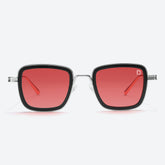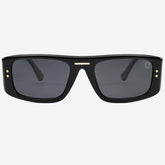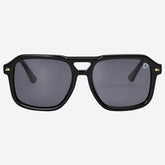Best Driving Sunglasses -A Comprehensive Guide to Selecting Sunglasses
For those of us who drive cars, we know how annoying it is when you turn around a bend, and the sun hits your eyes, blurring your vision. These few seconds of drama are annoying and life-threatening.
Did you know the National Highway Traffic Safety Administration says sun glare is responsible for about 3000 crashes annually and is the second environmental cause of accidents?
That's why you must wear sunglasses while driving unless you want to put your life on the line.
I'll help you identify the best sunglasses for driving in this article. Also, I'll tell you how to identify these glasses, and lastly, I'll show you glasses that match your eye style.
But the catch is you must stay with me to the end.
What are driving sunglasses?

Driving Sunglasses are glasses designed to reduce sun glare and eliminate contrast while driving. They are ideal for long trips and everyday travel. They help protect your eyes during the sun's high hours, especially early morning and late afternoon.
During these times, mainly during busy traffic hours, the sun is near your field of vision and directly in your sight, making it difficult for road users to see correctly, causing a safety hazard for you and those around you.
Getting the right sunglasses makes you feel comfortable and can save your life by reducing sun glares as it helps you focus better and lessen distractions while driving in everyday traffic.
While you might not need specific sunglasses designed especially for driving, there are essential features you must look for when purchasing one.
How to select the best driving sunglasses?

When shopping for your sunglasses, there are some qualities you should look out for. These features make driving a lot easier and safer. They include
UV Protection
It would be best to look for sunglasses that offer protection against UV-A, UV-B, and UV-C. Windshields these days have a UV-protecting coating, but most times, they are barely enough to wade off these UV rays. Opting for sunglasses with UV protection protects against UV rays and reduces eye discomfort.
Polarization
Polarization helps reduce or eliminate glare from reflective surfaces such as glass, snow, or water. Glares occur when light rays hit a reflecting horizontal surface, which causes light beams to scatter horizontally. This could make it difficult to distinguish colors and, in severe cases, can lead to vision loss.
Polarized sunglasses come with chemical filters that block horizontal rays, permitting only vertical light rays to pass through. This provides visual comfort and clarity and improves safety when you're supposed to squint or lose vision because of the reflected rays.
Colors of the lens
Look for neutral colors like gray, brown, black, and green lenses. They don't distort environmental colors but reduce eye strain and glare. We might be tempted to use flashy colors like pink or blue to appear trendy. However, they are bad choices.
Bright colors impair vision and make it difficult to know the true colors of the environment. You might have difficulty interpreting road signs and traffic lights. On cloudy days, wearing brown or amber [a darker shade of yellow] sunglasses is good. They make it easier to see when the light is low.
Lens tint
Lens tint refers to the amount of light the lens blocks. Sunglasses come in varying levels of tint. Light or medium tints are ideal for driving under normal lighting conditions. They reduce light glare and brightness but let you see your environment. Darker tints are the most suitable for intense lighting conditions.
Comfort
While functionality is critical, you must ensure you go for a frame style that's comfortable and fitting. You wouldn't want a situation where glasses are falling while driving. This could significantly increase the amount of sun rays that reach your eyes. Go for glasses that are a little bigger than your face.
What are the best sunglasses for driving?
Rectangular Polarized Oversized mirror sunglasses
The best sunglasses for driving are Rectangular polarized Oversized Mirror Driving Sunglasses. They combine the unique properties of mirrors and polarized glasses and have all the features of good driving sunglasses.
They are made from acetate and metal, which makes them durable and lightweight. These glasses provide 100% UV protection and are equipped with a filter that blocks intense light, effectively reducing glare and improving color recognition and contrast.
Its oversized frames provide extra coverage and protection. With these sunglasses, there is no more squirting or headache due to improper light balance. Aside from functionality, they have a unique texture that adds charm to your appearance and accentuates your personality.
Dollger Polarized Driving Sunglass

The Dollger Polarized sunglasses are stylish yet functional. They are made with special materials and have comfortable nose pads to make you look younger behind the wheel and prevent marks from appearing on your face after wearing them for a long time.
Its lens filters horizontal light waves from surfaces, reducing sun glares and improving your vision. Its square frame makes it suitable for all face types, and its curved temple arms ensure it is comfortable and pressure-free, making it ideal for protracted use.
How to care for your driving sunglasses?

While sunglasses have no shelf life, your pair can last for a long time if you can take proper care of them. Here's how to maintain your driving sunglasses.
Clean your sunglasses frequently.
It's essential to clean your sunglasses frequently, weekly or biweekly because they pick up dirt and grime from our skin when outdoors. To remove smudges and residue build-up, use microfiber or non-abrasive materials to remove dirt and smudges from the frames and lenses.
Wash the frame and lenses with soapy water and rinse with clean water.
Use warm water to rinse your sunglasses. You can use mild dishwashing soap to form a lather. Ensure you don't use moisturizers or harsh detergents. Rub the soapy water on your nose pads, frames, and lenses, then rinse off and use a microfiber to dry them.
Store sunglasses properly
When glasses are not used, please keep them in the protective case. Don't keep them on the dashboard or in the car, especially on hot days. Heat from the windshield can damage the lens and coating of your sunglasses.
Don't use harsh cleansers.
Never use vinegar, Windex, alcohol, or harsh household cleansers on your glasses. Ensure your hands are clean, and use only approved cleansers and a microfiber cloth. If the fabric is dirty, add it to the laundry and wash it properly. If you can't, get a new one.
Be cautious
Sunglasses are made with high-quality materials; however, you should be careful when handling them. It should be worn on your face, not your hand or any part of your body. When removing them from your face, use the temples. Check the screw, hinges, and nose pads to ensure they are secure.
Faqs on best driving sunglasses
Can I use Polarized lenses when driving at night?

Polarized sunglasses are designed to reduce glare and filter horizontal light rays. They work best when there's bright sunlight. However, the horizontal rays are reduced significantly at night, so wearing polarized sunglasses is not recommended as they might make it difficult for you to see. You could use Alloy Night Driving Aviator Sunglasses. They have yellow-tinted lenses that are polarized and anti-reflective, which helps improve visibility when driving at night or in very low light conditions.
Are Polarized sunglasses better?
Yes. Polarized sunglasses not only protect your eyes from UV rays but also improve visual clarity and reduce eye strain more than other regular lenses. If you squint a lot even when you wear sunglasses, consider purchasing polarized sunglasses.
Who are Polarized sunglasses not suitable for?
Polarized glasses are one of the best. However, they make LCD screens such as GPS or dashboards challenging to read, making them unsuitable for skiers and Pilots. But if you're a motorist, polarised sunglasses are your best bet.
Are mirror glasses better for driving?
Mirror sunglasses reduce sun glare and are stylish; however, polarized sunglasses will give you greater contrast and visual clarity, and better vision, making your road trip free of distractions and, consequently, safe driving. But if you love the classy style of mirror glasses, we recommend the Rectangular polarized oversized mirror driving sunglasses.
Conclusion
You've got everything you need to select suitable driving sunglasses.
To know if a sunglass is polarized. Look for a reflective surface that glares when light shines on it. You can use a mirror or a shiny surface. Ensure the glare is conspicuous from a distance of [60-90cm].
You can use a torch or overhead light to produce the glare. Hold the sunglasses at. 60°, one side higher than the other. Since they are polarized at one end, turning the glasses will make the polarization noticeable. You can also look through the lens; if the sunglasses are polarized, they will be dark. If you're skeptical about where to purchase your driving sunglasses, you can check Dollger square frame sunglasses.





